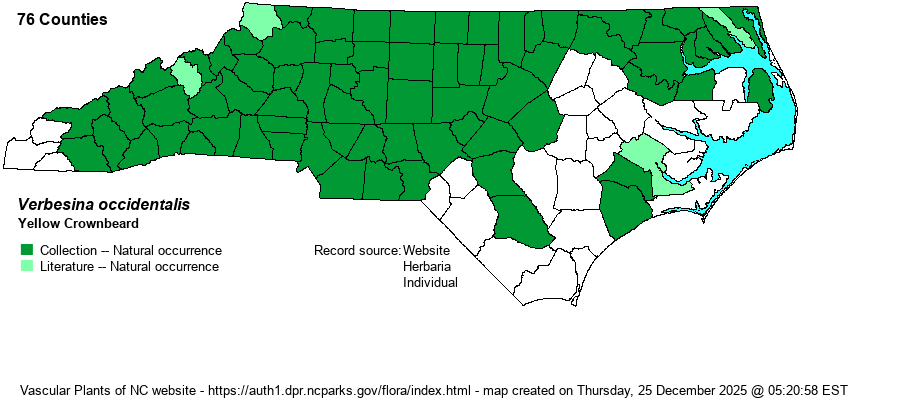| Author | (L.) Walter | |
| Distribution | Mountains, Piedmont, and northern Coastal Plain; several places elsewhere on the Coastal Plain with Piedmont ecology (e.g., Cape Fear River, or calcareous soil).
MD to OH and MO, south to northwestern FL and MS. | |
| Abundance | Common to abundant in the Piedmont and the northern Coastal Plain; common in the Mountains. Locally numerous in a few rich soil areas elsewhere in the Coastal Plain. Tends to be more numerous in the state than the similar V. alternifolia. | |
| Habitat | Mainly in wetlands, but also into uplands -- brownwater river floodplains and bottomlands, openings and clearings in these forests, marshes, moist woodlands, meadows, pastures, roadside ditches; edges of maritime forest. Can be common in mesic to rich upland soils of forest edges and thickets, but mainly where the soils are somewhat high pH. | |
| Phenology | Flowering and fruiting August-September. | |
| Identification | Yellow Crownbeard is easily identified by its tall stems 3-8 feet tall. Leaves are numerous, opposite, lance-shape or elliptic, sharply toothed, and strongly narrowed to a stalk (from a somewhat truncate base). The leafstalks are somewhat decurrent onto the stem as wings. Heads are numerous in an open array, and large -- ray florets are 1-3 cm long and bright yellow. The disks are prominent, dome-shape, and yellow. The rays are often twisted and thus the flowers look "unkempt". Wingstem (V. alternifolia) is very similar but always has alternate leaves. Both species seem to be increasing, at least spreading in wetland clearings such as sewerline margins. In fact, both can be somewhat weedy, as each can quickly invade man-made clearings in wetlands. | |
| Taxonomic Comments | None
| |
| Other Common Name(s) | Southern Crownbeard, Stick-weed | |
| State Rank | S5 | |
| Global Rank | G5 | |
| State Status | | |
| US Status | | |
| USACE-agcp | FACU link |
| USACE-emp | FACU link |

